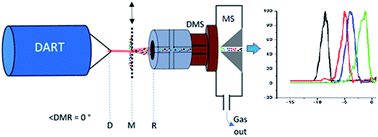Rapid pre-filtering of amphetamine and derivatives by direct analysis in real time (DART)-differential mobility spectrometry (DMS)†
Abstract
The synthesis of ‘designer drugs’ and derivatives has recently proliferated in the illicit drug market. For forensic drug analysis, conventional sample preparation and chromatographic separation techniques may be laborious and time-consuming. The characterization of these controlled substances may benefit from more rapid and high-throughput techniques. DMS (Differential Mobility Spectrometry), a variant of ion mobility spectrometry, is an emerging technology for post-ionization differentiation and filtration of isobaric interferences. When used before mass spectrometric analysis, DMS provides ion filtration on the order of milliseconds. Electro-sprayed DMS-MS studies have been implemented by various researchers for forensic studies. A complication associated with the introduction of sprayed ionization techniques is that the mechanism of solvent–ion interactions in DMS separation still remains unclear. In this study, we employ DART ionization as a robust solvent-less ionization technique coupled to DMS to demonstrate their combined utility and compatibility. Herein, amphetamine and derivatives were analyzed suggesting a promising alternative for rapid separation and characterization of new psychoactive substances.

- This article is part of the themed collection: Ambient Mass Spectrometry


 Please wait while we load your content...
Please wait while we load your content...